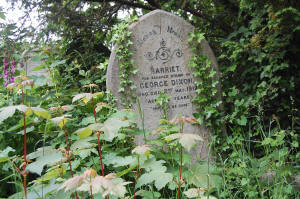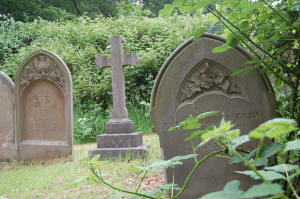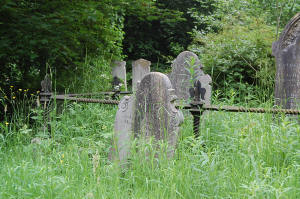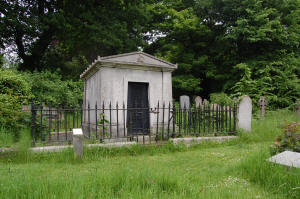|
|
|
|
|
The Rosary Cemetery (Thorpe Hamlet)
|
| 'The privilege of
purchasing Squares or Graves is open to
persons of every Religious Denomination, and all have
equally the privilege of using Funeral Rites and
Ceremonies, and of having the assistance of such
Ministers or Teachers as they may please.' |
The Rosary Cemetery lies off Rosary Road and is one
of Norwich's hidden treasures. It occupies a 13 acre
site on the hillside - with the oldest section
close to Rosary Road and the new section close to
Telegraph Lane East. Today the area is a wonderfully
overgrown labyrinth of trees, passageways and toppling gravestones.

Gravestone with Ivy and Sycamores

Graves and Brambles
It was founded in 1819 by a
Presbyterian minister named Thomas Drummond who used his
own savings to buy the plot - which was previously a
market garden. Up until then, the dead of
Norwich had been buried in the medieval churches and, by
that stage, many of the graveyards were piled high. (If
you walk down Tombland Alley past St. George's
churchyard - you'll notice that the soil is level with
the top of the wall. Other examples are St. John
Maddermarket or St. John the Baptist, Timberhill.) John
Evelyn, the diarist, who visited Norwich in October 1671
remarked:
|
| 'one thing I
observed of remark in this City, that most of the
church-yards (though some of them large enough) were
filled up with earth or rather the congestion of dead
bodies one upon another; for want of earth etc., to the
very top of the walls, and many above the walls, so as
the Churches seemed to be in pits.' |
|
Furthermore, non-conformists objected to being buried
according to the rites of a church to which they did not
belong and so Drummond's Rosary offered them a new
freedom.
Tragically, the first interment at the Rosary was
Drummond's wife Ann who died in childbirth aged 41. She
had originally been buried at the Octagon Chapel
Cemetery in Colegate, but she was re-interred in the new
cemetery in 1821.
The cemetery has a number of literary links. The
novelist Ralph Hale Mottram is buried here in the family
plot. Mottram, who was Lord Mayor of Norwich, was also
the last chairman of the trustees of the cemetery before
it was entrusted to Norwich Corporation in 1956. Mottram
was a non-conformist and worshipped at the Octagon
Chapel on Colegate. He is mainly remembered for his
trilogy of novels about the first world war The
Spanish Farm and for his books on local history such
as: If Stones Could Speak.

Grave of R.H. Mottram
Ada Nemesis Cooper, the adopted daughter
of the eye surgeon Emanuel Cooper (who has a grand
mausoleum on the cemetery) married the novelist John
Galsworthy and their family life together inspired
The Forsyte Saga. R.H. Mottram was also a friend of
Galsworthy and wrote his biography.

Emanuel Cooper
Mausoleum
Another attraction of the Rosary was that it offered
security against body snatchers - who in the early 1800s
frequently dug up corpses and sold them to anatomy
schools in London. However, there were obviously still
concerns as the following parody of Thomas Hood's
Mary's Ghost highlights:
|
You thought I was buried deep
Quite decent to the eye;
With roses growing o'er my grave,
In Dr-mm-d's Rosary.But William dear, my rest was short,
It was not very chary;
Them boney-men, they did march in,
And bore away your Mary.
I wish you'd speak to Mr D,
Who owns the patent ground;
And tell him that his patent graves,
Are neither safe or sound.
I vow that this new land of tombs;
Made so genteel and pretty;
Is not a bit safer than
Old Tombland in the City.
Alas! It is a joint-stock-thing,
The shares are down so low:
E're long they'll break up all the banks,
Of Dr-mmOnd, son &Co. |
A number of Norwich School painters are buried in the
Rosary including James Stark (1794-1859), John Thirtle
(1777-1839) and John Berney Ladbrooke (1803-1879) - son
of Robert Ladbrooke.
|
Links:
More Rosary Cemetery Photographs |
|
|
|

